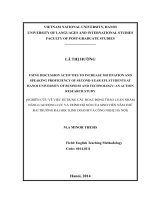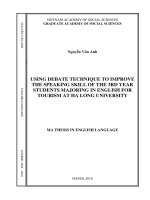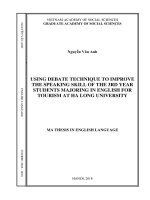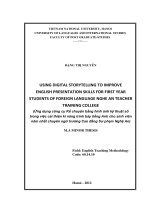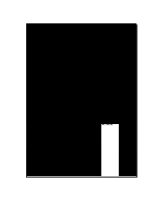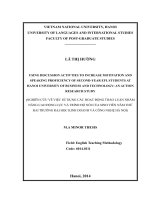USING PROBLEM-BASED LEARNING TO IMPROVE THE WRITING SKILLS OF THIRD YEAR NON-MAJOR STUDENTS AT HANOI UNIVERSITY OF HOME AFFAIRS
Bạn đang xem bản rút gọn của tài liệu. Xem và tải ngay bản đầy đủ của tài liệu tại đây (1.22 MB, 90 trang )
VIETNAM ACADEMY OF SOCIAL SCIENCES
GRADUATE ACADEMY OF SOCIAL SCIENCES
Lê Khánh Linh
USING PROBLEM-BASED LEARNING TO
IMPROVE THE WRITING SKILLS OF
THIRD YEAR NON-MAJOR STUDENTS AT
HANOI UNIVERSITY OF HOME AFFAIRS
MA THESIS IN ENGLISH LANGUAGE
HANOI, 2021
VIETNAM ACADEMY OF SOCIAL SCIENCES
GRADUATE ACADEMY OF SOCIAL SCIENCES
Lê Khánh Linh
USING PROBLEM-BASED LEARNING TO
IMPROVE THE WRITING SKILLS OF
THIRD YEAR NON-MAJOR STUDENTS AT
HANOI UNIVERSITY OF HOME AFFAIRS
Field: English Language
Code: 8 22 02 01
Supervisor: Đỗ Thị Thúy Vân, Ph.D.
HANOI, 2021
DECLARATION BY AUTHOR
I hereby sincerely state that the thesis titled “Using ProblemBased Learning to improve the writing skills of third year non-major
students at Hanoi University of Home Affairs” is the result of my own
research for the Degree of Master of Arts in English Language. The
things out of my masterpiece in this thesis are signed by citation and
referred in the references.
Except where reference has been made in the text, this thesis
contains no material previously published or written by another
person.The study reported in this thesis was approved by Graduate
Academy of Social Sciences.
Author’s Signature
Lê Khánh Linh
i
ACKNOWLEGDEMENTS
Although only one name appears as the author of this work, writing a
thesis is indeed a collaborative effort. I would like to express my sincere
thanks to the many people who made it possible.
First and foremost, I would like to express my heartfelt gratitude to my
M.A thesis’s supervisor,Đỗ Thị Thúy Vân, Ph.D. for her kind consultation,
invaluable encouragement as well as thorough correction in the process of
completion. But for her helpful guidance, this study would not have been
achieved.
Next, I would like to convey my sincere appreciation and thanks to Mr.
Đặng Nguyên Giang, Ph.D - Dean of the Department of Foreign Languages
and the other staff at Graduate Academy of Social Sciences the Department of
Foreign Languages, Graduate Academy of Social Sciences for granting me
the honor of writing this thesis as well as their assistance and most valuable
comments.
Especially, millions of my special thanks go to the lecturers and
students at Hanoi University of Home Affairs who participated in this study
for their kind and patient co-operation and encouragement. They helped
provide me with valuable data for the study so that I could have a better view
of activities in English classes at Hanoi University of Home Affairs.
Last but not least, I am deeply indebted to my family for their sympathy
and support during all the time I was studying for M.A degree at Graduate
Academy of Social Sciences. Without their unconditional love and sincere
contribution, I could not have overcome my difficulties and concentrated on
my studies.
ii
TABLE OF CONTENTS
DECLARATION BY AUTHOR ....................................................................... i
ACKNOWLEGDEMENTS .............................................................................. ii
TABLE OF CONTENTS ................................................................................. iii
ABSTRACT ..................................................................................................... vi
LIST OF TABLES .......................................................................................... vii
LIST OF FIGURES & CHARTS................................................................... viii
LIST OF ABBREVIATIONS .......................................................................... ix
CHAPTER 1: INTRODUCTION .................................................................. 1
1.1. Rationale ................................................................................................... 1
1.2. Aims of the Study ..................................................................................... 3
1.3. Research questions ................................................................................... 3
1.4. Scope of the Study .................................................................................... 3
1.5. Significane of the Study ........................................................................... 4
1.6. Research Methods .................................................................................... 4
1.7. Structure of the Study.............................................................................. 4
CHAPTER 2: LITERATURE REVIEW...................................................... 6
2.1. The Concept of Writing ........................................................................... 6
2.1.1. The definition of Writing ............................................................... 6
2.1.3. The Process of Writing ................................................................... 7
2.1.4.Characteristics of successful writing ............................................... 9
2.1.5. Assessing Writing Skills ............................................................... 10
2.1.6. Strategy in teaching writing ......................................................... 11
2.1.7. Discussion Text ............................................................................. 12
2.2 Problem – Based Learning ..................................................................... 14
2.2.1. Concept of Problem - Based Learning .......................................... 14
2.2.2. Correlation between problem based learning and discussion text. .... 15
iii
2.3. Previous Research ................................................................................. 16
2.4. Summary ................................................................................................. 18
CHAPTER 3: METHODOLOGY............................................................... 19
3.1. Research Setting .................................................................................... 19
3.2. Participants ............................................................................................. 20
3.2.1. The Researcher ............................................................................. 20
3.2.2. The Teachers ................................................................................ 20
3.2.3 The Students ................................................................................... 20
3.3. Research Procedure ............................................................................... 21
3.3.1. Identifying the problem................................................................. 21
3.3.2. Implementing the action research ................................................. 21
3.3.3. Doing Evaluation .......................................................................... 25
3.4. Data collection instruments .................................................................. 25
3.4.1. Observation ................................................................................... 25
3.4.2. Interview ....................................................................................... 26
3.4.3. Test ................................................................................................ 26
3.4.4. Questionnaire ................................................................................ 27
3.5. Data Analysis .......................................................................................... 28
3.6. Summary ................................................................................................. 29
CHAPTER 4: FINDINGS AND DISCUSSIONS ....................................... 30
4.1. Analysis of Writing tests ........................................................................ 30
4.2. Data Analysis from Questionnaires ...................................................... 35
4.3. Data Analysis from Interviews.............................................................. 45
4.4. Analysis of classroom observation ........................................................ 47
4.4.1. The first cycle – Week 1 – Module 1 and 2 .................................. 47
4.4.2 The second cycle – Week 2 – Module 3 and 4 .............................. 50
4.4.3. Class motivation assesssment ....................................................... 52
iv
4.5. Summary ................................................................................................. 54
CHAPTER V: CONCLUSION .................................................................... 55
5.1. Recapitulation ......................................................................................... 55
5.2. Concluding remarks............................................................................... 56
5.3. Implications ............................................................................................ 57
5.4. Limitations and Suggestions for Further Studies ............................... 58
5.4.1. Limitations .................................................................................... 58
5.4.2. Suggestions for Further Studies .................................................... 59
REFERENCES .............................................................................................. 60
APPENDIX 1: SCORING RUBRIC FOR WRITING TEST ........................... I
APPENDIX 2: PRE-TEST FOR STUDENTS ............................................... III
APPENDIX 3: SURVEY QUESTIONNAIRE ............................................... V
APPENDIX 4: POST-TEST FOR STUDENTS ........................................... VII
APPENDIX 5: INTERVIEW QUESTIONS .................................................. IX
APPENDIX 6: A SAMPLE OF LESSON PLAN .......................................... XI
APPENDIX 7: POST- TRYING OUT QUESTIONNAIRE ....................... XIII
APPENDIX 8 - OBSERVATION SHEET ................................................... XV
OVERALL CLASS MOTIVATION ............................................................ XV
APPENDIX 9: ENGLISH WRITING ABILITY EVALUATION ............XVII
v
ABSTRACT
Nowadays, English is becoming more and more important in almost
every area of life. English is a global language, and thus a compulsory subject
in schools and universities. Writing is one of the most critical skills of
research and practice. Being a university lecturer, I understand that we can
help our students find a better way to develop their writing skills and feel
confident when writing a paragraph or an essay. After learning certain
approaches to help students develop their writing skills. We chose to apply
Problem-Based Learning for our experimental writing courses. After this
experiment, two issues were identified: (1) student’s attitudes towards writing
classes; (2) the effectiveness of using Problem-Based Learning in teaching
and writing lessons. In order to conduct my action research with the
participants, I randomly selected an English class: 45 third year non-major
students at Hanoi University of Home Affairs. In 8 weeks, we carried out this
analysis and used questionnaires, pre-test, post-test and interviews to gather
data resources. The study shows that students have a positive attitude about
using Problem-Based Learning in writing classes, and this method was a good
way to help students develop their writing skills. Both lecturers and students
should find their own way of teaching and learning to achieve the best result
in writing skills in writing classes with the result we got in the findings.
vi
LIST OF TABLES
Table 4.1. Mean scores of pre-test and post-test ............................................. 31
Table 4.2. The scores of pre-test and post-test................................................ 32
Table 4.3. The changes after taking part in the lessons using ProblemBased Learning of students ............................................................................. 45
Table 4.4. The observation of teacher’s and students’ activities in Week 1 ........ 47
Table 4.5. The observation of teacher’s and students’ activities in Week 2 ........ 50
Table 4.6. Overall class motivation scores for all students ............................ 53
vii
LIST OF FIGURES & CHARTS
Chart 1: Students’ opinion of being afraid of writing a paragragh in
English ............................................................................................................. 36
Chart 2: Students’ frequency of writing English ............................................ 37
Chart 3: Students’s problem with writing skills ............................................. 38
Chart 4: Student’s frequency of practicing writing English ........................... 39
Chart 5: Students’ participation in writing activities ...................................... 40
Chart 6: Students’ opinions of using Problem Based Learning in writing
lessons ............................................................................................................. 41
Chart 7: Students’ opinions about their effectiveness of Problem-Based
Learning in improving writing skills .............................................................. 43
Chart 8: Students’ improvement for criteria after applying ProblemBased Learning in improve writing skills. ...................................................... 44
viii
LIST OF ABBREVIATIONS
EFL:
English as Foreign Language
PBL:
Problem-Based Learning
HUHA:
Hanoi University of Home Affairs
T:
Teacher
Ss:
Students
ix
CHAPTER 1: INTRODUCTION
This chapter introduces the rationale of the study, the aims, the
research questions, the scope, the methods, the significance, and the structure
of the study.
1.1. Rationale
Writing is the ability to express ideas that are organized on paper. It is
used to share information about everything to the reader in written form. It is
frequently useful as preparation for some other activity. It is a process of
discovering and organizing ideas, putting them on paper, and revising them.
By writing, we can express our ideas well. However, to get our meaning
strong, interesting, and clear for the reader, this skill must be improved by
practicing a lot. Because writing has many contributions to our life, we can
make a habit of writing to develop this skill.
Writing skills are considered the most difficult skill of language because
it involves mastering grammar, vocabulary, and spelling. In addition to that,
writing skills need thinking ability and logical skills to compose words into
meaningful sentences. Moreover, making organized text coherently is not an
easy part. The writer should make the composition as logical as possible. It is
started from the introductory paragraph to the conclusion. All of the
compositions should have logical ideas. Writing activity can be ready from
simple and then continue with comprehensive writing according to student’s
competencies and skills.
Then, looking at the point of writing skills at Hanoi University of Home
Affairs, a large number of the students in the classroom at Hanoi University
of Home Affairs take higher attention to reach success in the learning. In a
large number of the students occurs unconducive condition. The condition
1
occurs in the learning process such as the students do not take attention to the
learning activities. They change their focus by talking with their friends, some
of them are passive in the class, and they are careless with the material. This
condition makes it the teacher feeling hard to handle all of the students. From
that condition, a teacher should have a strategy to motivate the students to
participate actively in the experience of learning. One of the learning
strategies is to develop the skill of student’s thought (reasoning,
communicating, and connecting). A strategy of learning is Problem-Based
Learning. It is the educational strategy that helps students build the reasoning
and communication skills necessary for developing successful creativity.
Problem-Based Learning (PBL) is related to using intelligence from their
inner man in a community, or an environment to solve meaningful, relevant,
and contextual problems. Boud and Feletti (1997) stated that learning through
PBL is the most significant innovation in education. PBL curriculum helps to
increase the development of the study skills in a long life for open mindset,
reflection, critics, and active study. PBL curriculum is better to facilitate
students
to
solve
problems,
communication,
well-cooperation,
and
interpersonal skill than other strategies. By using strategy, hopefully, can
make the students more attractive in the teaching-learning process to make
them easier to understand and compose text. With the above reasons, the
researcher aspires to conduct a study on “Using Problem-Based Learning to
improve the writing skills of third year non-major students at Hanoi
University of Home Affairs” to find a better way for the teaching and
learning English writing skills and apply suitable techniques and activities in
English class.
2
1.2. Aims of the Study
This study aims to enhance the quality of teaching and learning
writing skill at HUHA. In order to reach the aim, the study is expected to
fulfil the following objectives:
- Investigating the third year students’s attitude towards the Problem-Based
Learning techniques used in writing lessons.
- Evaluating the effectiveness of applying Problem-Based Learning in
teaching and learning writing skills.
1.3. Research questions
For the objectives of the study, the following research questions are
addressed:
(1) What is the third year students’ attitude towards the use of Problem-Based
Learning of at Hanoi University of Home Affairs in writing lessons?
(2) To what extent can the Problem-Based Learning improve writing skills of
the third year students at HUHA?
1.4. Scope of the Study
The scope of English study is so broad. We may not be able to reach all
aspects to be studied as a whole. Particularly in the English learning context, there
are so many components that may become the concern of the study such as
students, the textbook used, the materials, the process of teaching-learning, etc.
In this study, the researcher focuses on the effectiveness of using
Problem-Based Learning to improve third year non-major students' writing
skills as well as their attitudes towards writing tasks. There will be forty-five
students participating in this action research. The average age of the students
3
is around 20. They are going to be the main subject to participate in and
respond to the survey questionnaires, the trial lessons, and the tests.
1.5. Significane of the Study
This research has some significances as following:
Theoretically, this study is expected to make a contribution to
development in teaching writing at HUHA to get more achievement not just
in methodology but in further development of as well. In addition, the
research findings will partly enrich the previous theories and research on EFL
teaching and learning, especially in teaching English writing skills.
Practically, it is highly hopeful that the results of the study can provide
the teachers of English at HUHA with a good alternative way for teaching
writing skills and they can make writing activities various. In the terms of
students, helps them enhance not only their working skills, especially
teamwork, but also skills of planning, critical thinking, and creativity ability.
1.6. Research Methods
To achieve the objectives, action research will be qualitatively and
quantitatively conducted. The data will be collected via class observation,
tests (pre-test and post-test), interviews, and survey questionnaires.
1.7. Structure of the Study
In addition to the references and appendices, the thesis consists of five
chapters:
Chapter 1 – Introduction: The first chapter talks about the rationale, aims of
the study, research questions, scope of the study, significance of the study, the
research method and the structure of the study.
4
Chapter 2 – Literature Review: This chapter focuses on an overview of
writing, the concepts of writing, Problem – Based Learning, the previous
studies on improving writing ability and summary.
Chapter 3 - Methodology: This chapter mainly focuses on the research
settings, participants, data collection instruments, research design and the
procedure of conducting Action Research for the study. In this chapter, the
detailed results of the surveys and a critical comprehensive analysis on the
data collected are also presented.
Chapter 4- Findings and Discussion: This chapter mentions the data analysis
from the Action Research results to build the foundation for the activities
recommended in Chapter 5.
Chapter 5 – Conclusion: This chapter sums up the study and suggests some
typical activities, practical tips to the other lecturers to make motivation to
students in writing activities when using PBL. This chapter also shows the
limitations of the study and gives suggestions for further study to help the
next researchers gain the better results.
5
CHAPTER 2: LITERATURE REVIEW
This chapter discusses the relevant research literature, including an
overview of writing, the definition of problem-based learning, its efficiency,
and the benefits of using in teaching and learning. The researcher also notes
the literature gap and demonstrates why the current research should be
conducted to bridge the gap.
2.1. The Concept of Writing
2.1.1. The definition of Writing
Writing is a way to produce language, which we do naturally when we
want to express something in written form. It is the same with the other skills
that we need to take much time to think of our subject. If we want to take
writing in a second language, we also take much time to revise our work. We
must consider our choice of words, the form, and grammatical structure so
that the reader can understand our writing easily.
“Writing is a process of creating, organizing, writing, and polishing”
(Oshima and Hogue, 2006). From that definition it can be concluded that
writing is a process of creating letters as a medium of communication that
must consider the mechanics of writing such as spelling, punctuation,
capitalization, paragraphing.
Becoming a good writer is not easy, some steps must be done to be a
good writer. They are such practicing it every day, write with your way; write
everything in your mind without being afraid to make it wrong, challenge
yourself; write with a particular topic to make your writing is better.
Writing is often taught in such a way that student failures, rather than
success are focused on. The writing process is familiar learned by students in
their school and environment. Creative use of language, intentive thinking,
and critical reasoning will produce great artificial writing. There are three
6
general purposes of writing and they can all occur in a single essay, although
usually one of the purposes is dominant, they are to explain (educate, inform),
to entertain (amuse, give pleasure), and to persuade (convince, change the
reader’s mind).
2.1.2 The importance of teaching and learning writing skills
Writing is an action that creates a meaningful text or sentence from the
mind. It does not only express ideas but also provides information for the
media in many ways. Vietnamese students, therefore, need good writing skills
to express their thoughts in writing to inform the reader.
One of the aims of English is to enable students to write effectively.
Learning to write is a process in which ideas are uncovered and organized,
put on paper, and reworked and revised. It means that learning to write is a
process of finding and constructing ideas. Writing is therefore the hardest
lesson in school since the students have to write the text using English. They
must write what they think and put it on a paper using the right procedure.
Writing, on the other hand, is regarded as the most difficult language
skill to learn. Furthermore, the teaching and learning of writing skills in the
classroom has a small portion and is often overlooked. Writing plays an
important role in human life, whether for academic purposes or in other areas.
2.1.3. The Process of Writing
In short, the writing process comprises the mechanics by which writers
create publishable products. It is the method all writers use to generate ideas,
choose and organize these ideas, write and revise their pieces, and format
them for publication (Sundem, 2007).
Writing process instruction is just that process-oriented and encourages
writers to discover for themselves the mechanics of composition. At least
7
toward the beginning of the year, encourage students to use the following
steps:
a. Prewriting
The first step in the writing process is to choose a topic and collect
information. The writers put their ideas and their thought in order.
They may think about the subject and the purpose of what they will
write. They use their mind to explore ideas and thought freely.
b. Drafting
In this part, the writers outline the topic. While drafting, the writers
revise as little as possible. It will not be a matter if the writers make many
mistakes. They just need to write fast based on their ideas.
c. Revising
Revising is to make the students’ learning technique is better. Students
will see “before” and “after” versions, and by comparing the two, they will
demonstrate to themselves the specific elements that make for a better piece
of writing. The revising process is to improve the result. It checks content and
organization, including unity, coherence, and logic.
d. Editing (Proofreading)
In this part of process writing, the writers should be aware of technical
writing process such as grammar, sentence structures, spelling and
punctuation.
e. Publishing
In this part of writing the students communicate their writing through the
presentation. Like the attention to conventions, the neatness and presentation
of a piece of writing will help ensure that readers take it seriously.
8
2.1.4.Characteristics of successful writing
Some individuals believe that writing merely implies writing that is free
of faults, such as grammar, punctuation, and spelling, based on their school
experiences. However, successful writing entails much more than simply
writing correctly. Writing that is successful answers to the interests and
requirements of its target audience while also reflecting the writer's
personality and originality.
Successful writing is frequently the consequence of labor and practice as
much as skill. It might be encouraged to know that writing successfully is not
always a talent, or a luxury granted to only a few individuals. You can
enhance your writing if you're prepared to make effort.
If you follow these established rules for effective writing when writing
term papers or essays for school, or if you go on to a career as a professional
writer—be it as a technical writer, journalist, copywriter, or speechwriter you should be able to excel, or at least perform competently for any given
assignment:
- Good writing has a clearly defined purpose.
- It makes a definite point.
- It supports that point with specific information.
- The information is clearly connected and arranged.
While knowing appropriate grammar, spelling, and punctuation does not
guarantee that you will be a successful writer, these fundamentals are more
important in academic and professional writing than in most other genres.
The key to producing academic or professional writing that people want
to read is to strike a balance between the aforementioned elements and a
unique voice. Consider the work, no matter how scholarly, as a contribution
9
to a dialogue. The duty of the writer is to make the information that
attempting to deliver as clear and understandable as possible.
2.1.5. Assessing Writing Skills
Assessment is an ongoing process that encompasses a much wider
domain. When the students respond to a question, give a comment or try out a
new word or structure, the teacher will make the assessment. It is on the
students’ performance.
Assessment designates four related processes: deciding what to measure,
selecting or constructing appropriate measurement instruments, administering
the instruments, and collecting information (William, 2003).
Writing assessment must consider students’ writing ability. It is not a
simple task for the teachers. It requires teachers to consider a complex array
of variables, the teacher needs to be clear about the objective and the criteria
of assessment. Some aspects must be considered in writing, they are content,
organization, vocabulary, language use, and mechanics.
One method that can be used in assessing writing is test. Testing writing
skills are complex and something difficult to teach, requiring mastery not
only of grammatical and rhetorical devices but also of conceptual and
judgmental elements. The following are varied skills necessary for writing
good prose as suggested by Heaton (1991):
a. Language use: the ability to write correct and appropriate sentences.
b. Mechanical skills: the ability to use correctly those conventions
peculiar to the written language, e.g. punctuation, spelling.
c. Treatment of content: the ability to think creatively and develop
thoughts, including all irrelevant information.
d. Stylistic skills: the ability to manipulate sentences and paragraphs,
and use language effectively.
10
e. Judgment skills : the ability to write in an appropriate manner for a
particular purpose with a particular audience in mind, together with an
activity to select, organize, order the relevant information.
2.1.6. Strategy in teaching writing
Contextual Teaching and Learning
In this strategy of learning, the teaching – learning process does not
transfer the knowledge from the teacher to the students by memorizing
many concepts but it facilitates the students to touch the real life of their
daily life.
Cooperative Learning
According to Savage, Cooperative Learning is an approach that is
concerned with working together in a group.
Cooperative Learning is a learning strategy where the students learn
together in a group. One communicates the idea to the other in the group.
They share their experience to their friend relates to the material.
Thematic Learning
Thematic Learning is an integrated model of learning that uses thematic
approach involved several lessons to give meaningful experience for the
students. The model of Thematic learning relates one lesson to the other
lesson. The Thematic concept is that the teacher and the students are together
to choose a theme in the learning process.
Problem-Based Learning
Problem-Based Learning is a strategy in teaching writing where the
students actively participated in learning. They analyzed problem situation of
the topic to find the solution.
11
2.1.7. Discussion Text
2.1.7.1. Definition
Discussion text is categorized as factual text. It presents differing
opinion view points or perspectives on an issue, enabling the readers to
explore different idea before making conclusion.
The genre of arguing is an important and influential language process,
essential for dealing with many aspects of school knowledge and effective
social participation. It is a process that involves reasoning, evaluation and
persuasion (Knapp and Watkins, 2005).
The purpose of discusssion text is to present different opinion, view
opinion or perspective on an issue. As Anderson (1997) stated that the
purpose of discussion text is to present to the audience different opinions on a
topic and, at the end is your opinion.
2.1.7.2. Generic Structure
A discussion text is organized through a schematic structure. It is a
kind of rule to gain the writing goal. The structure is as following:
Issue
In this part of issue contains of statement. a statement supplys
necessary background information. A discussion begins with a brief
introduction describing situation. This introduction recognises that there are
two points of view.
Argument
In this part the writers give their argument which it consists of giving
argument for and argument against. Argument for is giving support idea for
the issue while argument against is giving contrary idea for the issue. In other
12
word argument for is called pros and argument against is called cons. ‘Pros’
means advantage and ‘cons’ means disadvantage of something.
When making pros and cons the writer should make it balance. The
writer can make pros and cons on a list. Use these guidelines to make better
pro-con lists.
Conclusion or recommendation
The discussion ends by presenting a personal point of view before
making conclusion. The conclusion or recommendation may sum up both
sides of arguments if they are fairly balanced, or it can be one argument if
providing sufficient evidence.
2.1.7.3. Language Feature
- Focus on generic human and generic non-human participants. The
topic of discussion text may tell about phenomenon or social issue in the
environment.
- Use of mainly material, mental and relational processes. Material
process is process of material doing e.g: go, run, mental process is process
used to express sense such as feeling, thinking, perceiving, e.g: like, believe,
relational process is process to link between information in another word is
linking verb, e.g: are, could have.
- Use of temporal and causal conjunctives relations. Temporal
conjunctive relation tells about time, e.g: when, since, while, now, then, at
first, as, by the time, finally. Causal conjunctive relation tells the link point in
the argument, e.g: because.
- Use of modality such as can, could, may, might, will, would.
- Use of logical conjunctives relation e.g: therefore, however.
13
2.2 Problem-Based Learning
2.2.1. Concept of Problem-Based Learning
In the Problem-Based Learning strategy, the word "problem" refers to a
discrepancy. It is a disparity between the actual situation and what was hoped
for. The problem can pique the learners' interest during the learning process.
Learners may be interested in observing and participating in something. It
means that the learners actively participated in the learning process in order to
find a solution.
Problem-Based Learning (PBL) is a group of teaching learning process
that is focused to the process of problem solving which is faced scientifically.
PBL is designed in the late 1970s. It is kind of approach that challenges
students to learn through engagement in a real problem. This method is
students-centered that refers to give relevant opportunities to the students. It
will make a fundamental shift from a focus on teaching to a focus on learning.
The process in PBL is aimed at using the power of authentic problem solving
to engage students and enhance their learning and motivation.
This is an instructional method that encourages the students to apply
critical thinking, problem solving skill and content knowledge to real world
problems and issues. Instruction in this strategy is student centered. It is likely
to include discussion, reflection, research, project, and presentation. PBL
starts with an issue, case, or a structured problem that can be researched,
studied, or even solved (give solution). A teacher’s role in this method is to
pose problems, ask question, and facilitate investigation.
Problem-Based Learning has some advantages such as the students are
known to develop greater communicative, thinking and problem solving skills
with it than with regular lecture based education, PBL encourages students to
14

